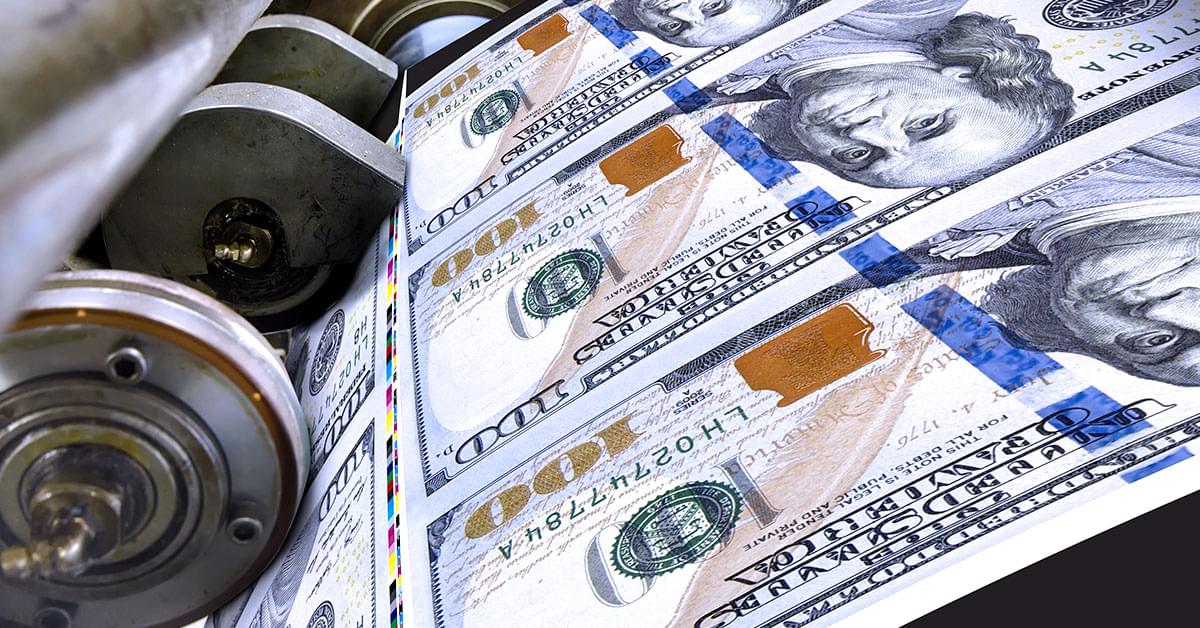
In simple terms, quantitative easing is a monetary policy where central banks will buy financial assets – often their own government bonds or other securities. This causes an injection of money into the financial system.
Central banks will create money to buy these financial assets, therefore putting more cash into the economy. For this reason, quantitative easing is good for stimulating economic growth, but introduces risks of inflation.

How does quantitative easing work?
Quantitative easing (QE) comes in the form of monetary policy introduced by central banks. The Bank of England and US federal reserve are both currently implementing quantitative easing policies.
Central banks will often use quantitative easing in times of economic downturn or a financial crisis. Deflationary pressures can also be a factor. Generally speaking, whenever there is a downturn in spending and economic activity, quantitative easing will boost economic activity and raise inflation to a healthy level, as well as increase lending and money supply.
Quantitative easing aims to work in the following way:
1. Asset purchasing
Banks will create a certain amount of money with which to buy a predetermined amount of financial assets. This will normally be government bonds, one of the most secure investments, but can also consist of corporate bonds, and sometimes even stocks.
2. Increase in reserves
This process is simple, but creates some significant results. Central banks buying financial assets means the amount of money in the economy increases, which causes interest rates over the longer-term to decrease. This in turn lowers the cost of borrowing, which means borrowing will increase, and therefore economic activity.
3. Increase in asset demand
As central banks are purchasing assets, often in huge volume, the increased demand for these assets will increase their value. Furthermore, as bonds rise in value, their interest rates (yields) will fall. All of these factors will further increase borrowing and spending, by both customers and businesses.
These three factors can be boiled down into the basic goal of quantitative easing, which is to make borrowing and investing cheaper to encourage spending and lending, therefore boosting the economy.
Advantages of quantitative easing
Quantitative easing is used by many governments to steer the economy into favourable conditions.
Stimulates economic activity
As mentioned previously, this is the main goal of quantitative easing, and it has proven to be effective. With the injection of money into the system, the economy can prosper hugely from this strategy, and can be used to recover from economic turmoil.
Boosts sentiment
Quantitative easing doesn’t just benefit the economy directly from itself. The effects of quantitative easing ripple throughout the entire economy, and increase positive sentiment in the economy. As Bill Merz, head of fixed income research at U.S. Bank Wealth Management in Minneapolis, remarked in Forbes: “it’s a powerful signal that the Fed wants to stimulate economic growth, and that is an influential force on capital markets and asset prices.”
Lending and spending is increased, which in turn increases profits for businesses, leading to further economic activity and a general confidence in the economy from the public. This can then lead to increased consumer spending and activity, which is healthy for an economy.
Fights deflation & economic slumps
If the economy of a country is experiencing deflation, or falling into a deflationary spiral, then quantitative easing can reverse this. The injection of money into the economy boosts spending and lending, and also inflation, which is sometimes necessary if deflation is a possibility.
Liquidity issues can also be a big part of an economic downturn. With quantitative easing, additional funds are injected into the economy, and prices can become more stable, in effect making the entire system more liquid.

Disadvantages of quantitative easing
Not all economists are fans of quantitative easing. Many cite quantitative easing as increasing inflation beyond what it needs to be, and creating asset bubbles. A report from the UK government referred to quantitative easing as a “dangerous addiction”, as while it can have benefits to an economy, these benefits can quickly sour, highlighting the potential snowball effect.
Risk of inflation
As in principle, more money is being created, there is the potential for excessive money supply growth, which will lead to inflation. A small amount of inflation is healthy for an economy, and many central banks aim for 2% as the ideal. However, quantitative easing can push an economy into unnatural levels of inflation, which can be difficult to reverse.
Asset bubbles
Injecting heaps of cash into certain assets this way will increase their value, which is intended. But this can create economic bubbles, as the price is effectively being inflated beyond its true value. This can be in sectors such as real estate or stocks, and can cause significant economic turmoil if they burst.
Creates income inequality
Critics of quantitative easing have pointed out that it creates economic inequality, something that the UK government has noted in a report. This is simply because during quantitative easing, asset value increases, and assets are generally owned by those in a wealthier position, so their wealth increases.
Exit challenges
Once monetary policy has adopted quantitative easing, it can be difficult to stop. Unwinding the process can also be incredibly challenging, and potentially upset the economy if done incorrectly.
The benefits and downsides of quantitative easing often depend on how effectively it has been implemented by a particular government, and whether it was the correct move under the particular economic conditions.
Under careful management and properly regulated, it can be a huge benefit to an economy – poorly implemented and it can be a disastrous decision.
Is quantitative easing just printing money?
Quantitative easing is not just simply printing money, but the process does involve creating more money. However, there is no physical printing of more bank notes, as most money now is held digitally.
Furthermore, the central banks will create this new money specifically to buy assets and achieve a stable influx of cash into the economy, not to simply disperse without regulation.
For more articles on currency and economics, make sure to stay posted on our weekly articles at CurrencyTransfer on our Expert Analysis section. We also post daily updates on the market with our Market Commentary.
Sign up for an account with CurrencyTransfer today for free, and you’ll be assigned an account manager who will help you every step of the way.
Caleb Hinton
Caleb is a writer specialising in financial copy. He has a background in copywriting, banking, digital wallets, and SEO – and enjoys writing in his spare time too, as well as language learning, chess and investing.



